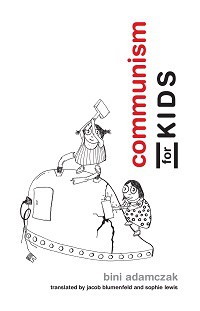The Politics of Children’s Literature

 Parents have always screened their children’s reading material literature for content and language. But these screenings usually don’t include worries about questionable political theories. It might seem odd to bother oneself with a worldview shakedown of your nephew’s favorite bedtime story—unless, of course, his favorite bedtime story happens to be Communism for Kids.
Parents have always screened their children’s reading material literature for content and language. But these screenings usually don’t include worries about questionable political theories. It might seem odd to bother oneself with a worldview shakedown of your nephew’s favorite bedtime story—unless, of course, his favorite bedtime story happens to be Communism for Kids.
Recently published by MIT Press, Communism for Kids made its way to the U.S. from Berlin-based author Bini Adamczak. The story, translated by Jacob Blumenfeld and Sophie Lewis, tells a fairytale of “jealous princesses, displaced peasants, mean bosses, and tired workers.” The book’s summary predicts that “Before you know it, readers are learning about the economic history of feudalism, class struggles of capitalism, and more.”
If the title doesn’t warn you away from a purchase, perhaps the zombie-eyed child workers of the cover art will. Unfortunately spotting troubling themes in children’s books isn’t always that easy. Sometimes, we have to dig a little deeper than cover and summary. Take the popular title The Rainbow Fish.
For those not familiar with the 1992 German book (and popular American cartoon show), author Marcus Pfister tells a story ostensibly about the dangers of vanity and importance of sharing. The title character’s coming-of-age adventure starts when he cannot seem to make friends due to his unwillingness to give away his special, shiny scales to other fish. His community ostracizes him as punishment, until a wise octopus reveals to the troubled Rainbow Fish that his selfishness has led to his life of solitude. He is advised that he will only “discover happiness” if he gives away his scales to the community.
He finally decides to give away one scale, and the recipient circulates the news. Soon enough, Rainbow Fish is surrounded by the fishes who once ignored him, and he continues the distribution process. Once the aquatic neighborhood is emancipated from any sign of individuality and every fish has exactly one of his flashy scales, he has more friends than he can count. Clearly, a socialist or communist society in which all valuable things are equally distributed is preferred in this tale—even if it means losing an appendage or two.
Fortunately, we can also find fantastic children’s stories that kids about concepts like individualism, entrepreneurship, comparative advantage, and spontaneous order. The same year that The Rainbow Fish was published, John Trent’s The Treasure Tree hit bookshelves across the nation. It is the tale of four animal friends—a Golden Retriever, an Otter, a Lion, and a Beaver—who embark on a treasure hunt. Through a myriad of plot twists and adventures, they discover that employing their many different talents and strengths is the only way to find the treasure. Each character solves a challenge through their own innovation and talent to find a key. Later, these keys are placed together to form one large key that unlocks the treasure.
Judy Schachner’s Skippyjon Jones stories also showcase an individualist spirit. Skippyjon, a Siamese kitten who dreams of being a Chihuahua, is imaginative and creative, and embarks on wild adventures. He is often ridiculed and questioned for his unusual behavior, but never allows doubt to stop him. In Class Action, his own mother tries to stop him from attending a “dogs only” school. Ignoring expectations, he attends class anyway and becomes a pack leader.
When evaluating our own lives, how much can we say children’s stories influenced us? For most, at least one favorite impacted us greatly. From the overt example to the classics with an subtle message, it matters what goes into the minds of still-forming humans. Liberty-loving individuals with children in their lives should take a second look at what’s on the shelf.